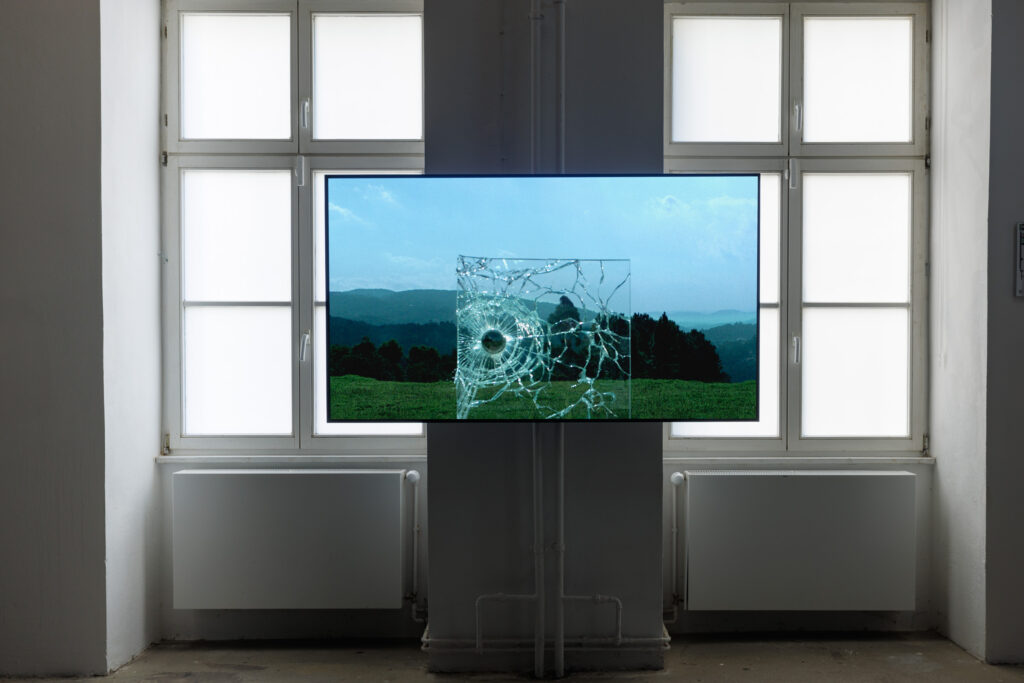QUEER TIME AT KW INSTITUTE

''The constantly diminishing future creates a new emphasis on the here, the present, the now.'' – Jack Halberstam, In A Queer Time and Place: Transgender Bodies, Subcultural Lives (2005)
Jesse Slater for EXIT Magazine © 2024
Few concepts occupy my mind as Jack Halberstam's queer time does. It's disruptive, challenging the traditional, linear view of life, masticated into a digestible pulp by marriage, career, and retirement. Instead, Halberstam argues that queer time exists outside the normative timeline, often in response to social precarity or inadequate healthcare. Rather than looking to the future, queer time is grounded in the present, in living life moment to moment. As I moved between exhibitions Ruins of Rooms and Estufa at KW Institute, Halberstam's words "the here, the present, the now" were with me. Both exhibitions grapple with queer time, whether by embracing the immediacy of the present, or by remoulding time into something fluid and malleable.
On the top floor of KW Institute, Ruins of Rooms anchors me firmly in the present. The exhibition pairs Jimmy DeSana's electric, intimate portraiture with Paul P.'s soft, fragile, and watery paintings. What strikes me first is how the works feel calm and ecstatic at the same time. Both artists find their subjects in queer subcultures of the 1960s to 1980s, Paul P. through erotic gay magazines in the LGBTQ2+ archives in Toronto, and Jimmy DeSana through his lived experience.
The photographs of DeSana's I'm drawn to are the ones capturing queer lovers and friends mid-moment. In his series 101 Nudes, he places friends in middle-class domestic scenes. They're silly and fun, like a sort of drag. More than anything, DeSana's work brings me sharply into my own body. There's a timeless gooeyness to it—a space where everything else melts away, leaving just us, the bodies in the room, playing.
Paul P.'s portraits are quiet in comparison. They depict people shoulders up, laying backwards. They could be portraits of people sleeping, or could be death masks, or the moment of orgasm. The paintings drip from the paper like they're alive, vulnerable. Fluorescent colours streak across otherwise grey faces. Paul P. catches his subjects mid-surrender, some moment of letting go, and we're invited to quietly bear witness.
As I walk around, I realise the exhibition design keeps me present too. False walls divide up and cosy an otherwise white cube space. Some corners feel private. A window in the shape of an archway is cut into one of the walls. As I move from looking at a photograph to following the arch's smooth curve, I catch someone looking from the other side. They smile. I shy-smile back, suddenly aware of my part of the exhibition's choreography, not just as an observer. Am I just looking at art? The line between voyeur and participant blurs as bodies shift in and out of view.
Ruins of Rooms may be grounded in the present, but Luiz Roque's Estufa, just downstairs, plays with the very fabric of time itself. Roque creates a sci-fi cosmos where time bends, melts, and reverses, dismantling its structure entirely. His work offers visions of alternative realities, particularly for queer and trans people. In Modern, the first video works on display, Roque confronts modernism itself, questioning the drive for newness and progress. The video seems to be set in Tate Britain, where a figure in a black latex gimp suit—channelling party icon of the 80s London club scene Leigh Bowery—dances provocatively around Henry Moore's sculpture Recumbent Figure, seeming to taunt it. The tension between canon and underground, between straight and queer, between old and new, collapses as the two smoothed over faces twist around each other. For me, it breaks the idea of 'now' entirely, creating a space of timelessness.
Throughout the exhibition, Roque continues to distort expectations of time, often reversing sections of his videos so actions unfold in reverse. In Geometria Descritiva, for example, a metal ball is thrown at a pane of glass in front of a scenic green hillside. We watch as the glass shatters, but the scene plays out in reverse slow motion—the shards dancing backwards, reforming the whole. The destruction unravels before our eyes, suggesting that transformation, like time itself, isn't locked into one outcome but can be rewound, replayed, or reimagined altogether.

This focus on the present, and the potential to reshape it, brings me back to Halberstam's idea of the "constantly diminishing future." Halberstam argues that queer time isn't about aiming for a distant goal, but about existing fully in each fleeting moment. For many queer people, the future is uncertain, precarious. Jimmy DeSana himself died from AIDS in 1990, a reminder of the fragility of queer existence, and that of other marginalised people. The work Ano Branco by Roque included also underlines disparity in medical care as a trans woman goes from flirtatious moment bathed in golden-hour sunlight to seeking gender-affirming treatment at a shoddy, robotically-controlled, closing-down clinic. The exhibitions underline this disparity at the same time as celebrating the endless possibility of breaking away from convention, when time can be claimed as your own. Together, Ruins of Rooms and Estufa converse on what it means to inhabit queer time, whether in the fierce embrace of the now, or rewiring our idea of time and what we do with our lives entirely.

Jesse Slater is a curator and writer whose interests lie in messiness, ephemerality, and queering means of artistic production. They live and work in Berlin.
Contact: jesse (at) exit030.com

